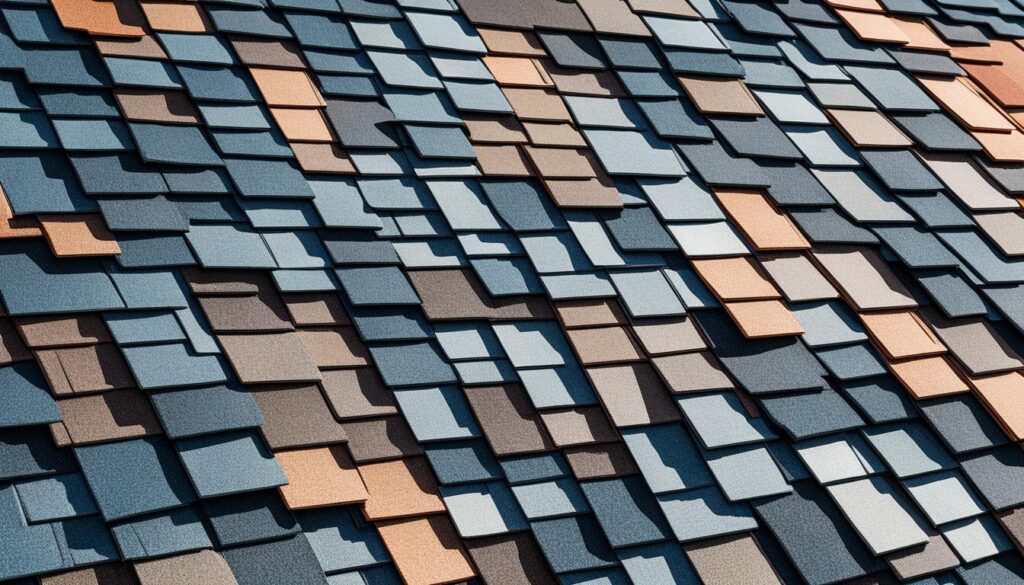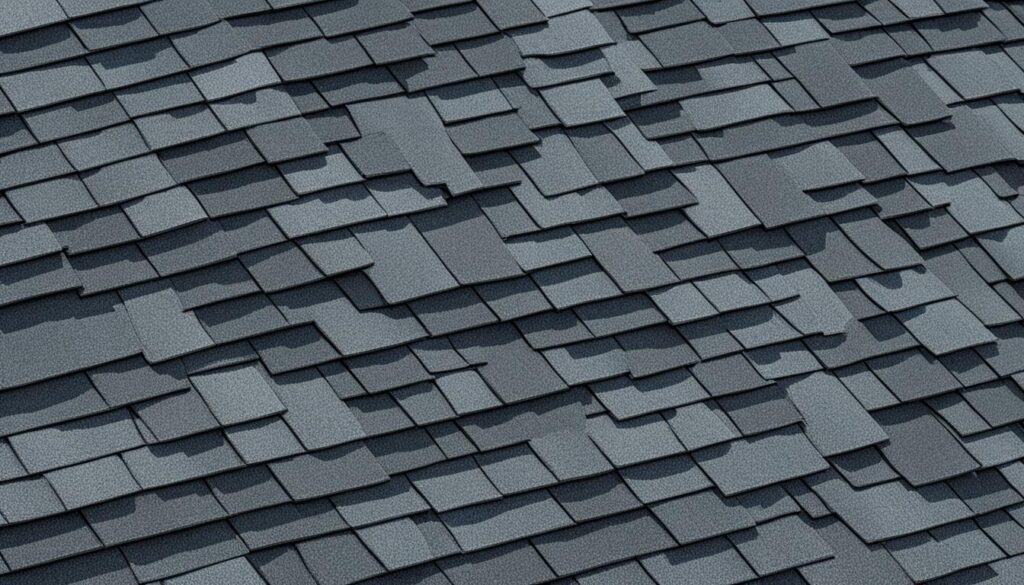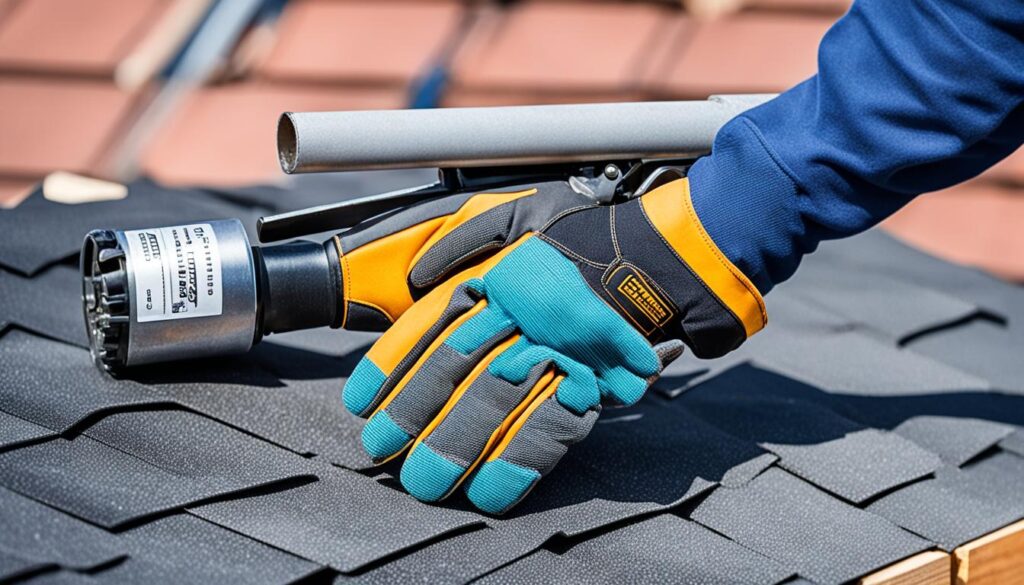
Looking for the best flat roof shingles to keep your home safe? There are many types out there that can help. Plus, installing them the right way is key to making them last. Choosing well can protect your home from bad weather and make it look good.
This guide will help you learn all you need about flat roof shingles. We’ll cover the different types and how to install them. It’s useful whether you plan to do it yourself or hire someone. You’ll get the info you need to pick the best for your home.
Key Takeaways:
- Choose the best flat roof shingles to protect your home and enhance its aesthetic appeal.
- Explore the different types of flat roof shingles available and understand their benefits.
- Learn essential installation tips for a durable and long-lasting roof.
- Consider factors such as cost, durability, and maintenance when selecting flat roof shingles.
- Whether you’re a DIY enthusiast or hiring professionals, this guide will provide the information you need.
Essentials of Shingle Roofing
Knowing about roof shingles is key for a roof that lasts. They protect your home from bad weather. Shingles make your house look nice, too. You can choose from asphalt, wood, and metal shingles, each having good and bad points.
Asphalt shingles are a popular choice. They’re affordable and last a long time. They come in many colors and styles to match your home. Wood shingles have a pretty, natural look. But, they need more care to avoid rot.
Metal shingles are super strong and can last a lifetime. They stand up to fire and tough weather well. Yet, they cost more than asphalt or wood.
Getting your roof installed correctly is vital. First, check the roof for damage. Make sure the flashing is correct and an underlayment is put in. Adding a drip edge and water shield boosts protection from leaks.
Keeping your shingle roof in good shape takes work. It’s smart to do regular checks and clean outs. This stops small problems from getting bigger.
Learning about shingle roofs and picking the right type helps. Proper install and maintenance keep your roof strong. This protects your home for a long time.
Selecting the Right Material for Your Roof Shingles
Choosing the right roof shingle material is vital. It affects your home’s look and protection. You can pick from asphalt, wood, and metal shingles.
Asphalt Shingles
Asphalt shingles are common for homes. They’re cheap and easy to put on. You can choose from many colors and styles. They are tough and stand up to fire and wind well.
Wood Shingles
Wood shingles give your roof a natural, classic look. They are usually cedar or redwood. These shingles are good insulators and handle bad weather. But, they need care to avoid rot.
Metal Shingles
Metal shingles, like aluminum or steel, are getting more popular. They are super durable, lasting over 50 years. These shingles don’t burn, rot, or get eaten by bugs. They also keep your house cool.
When picking shingles, think about your style and where you live. Also, consider your home’s structure. All materials have good and bad points. So, choose what’s best for your home and budget.

Preparing the Roof for Shingling
Before you start adding new shingles, it’s key to get your roof ready. Make sure you have all you need for a successful shingle job. This protects your house and makes it look better.
First, check that the roof decking is solid. It’s beneath the shingles and needs to be in good shape. Fix any damage or rot to have a strong base for your new shingles.
Don’t forget about roof flashing. It keeps water out around chimneys, vents, and skylights. Check and fix any broken flashing to keep your roof watertight.
Adding underlayment is another important step. It goes on top of the decking to keep out water. This protects your home from leaks and damage.
Consider a drip edge to help water flow off your roof. It’s a metal strip along the roof edge. This keeps the roof’s edge dry and your shingles lasting longer.
For extra protection from water, use an ice and water shield. It sticks to the roof and keeps out water. Use it in wet or cold areas for the best defense.
Choosing the Right Asphalt Shingles
When picking asphalt shingles, think about your area’s weather and your home’s style. There are many styles and colors to choose from. This lets you make your roof look the way you want.

Three-tab shingles are a budget-friendly option. They are flat and work well for many homes. If you want something stronger and with more depth, think about architectural shingles. They look more textured and last longer.
Make sure you pick high-quality shingles. Choose from brands that guarantee their work. This way, your roof will look good and protect your home for many years.
Step-by-Step Guide to Shingling Your Roof
Putting up a shingle roof takes time and careful work. It’s important to plan and pay attention to details. Whether you’re a homeowner or a professional roofer, following a step-by-step guide is key to success. This guide will help you from start to finish, ensuring your roof is sturdy, good-looking, and lasts a long time.
First, get all the tools and materials you need. You’ll need a hammer, roofing nails, a utility knife, a chalk line, and a ladder. Make sure you choose the right shingles for your roof’s style and the weather where you live.
Before you start laying shingles, the roof surface must be prepped. The roof decking should be checked for any damage or rot. Add roof flashing around things like chimneys and vents to avoid leaks. Also, put down an underlayment to keep moisture out.
Step 1: Laying the First Row
Place the first row of shingles at the roof’s edge as the manufacturer suggests. Use a chalk line to make a line for the shingles to follow. Then, nail the shingles down. Be sure the nails go through both the shingles and the decking.
It’s crucial to follow how many nails and exactly where to put them as the manufacturer guides. Don’t hit the nails too hard or you might damage the shingles. Keep placing shingles, making sure they align and overlap correctly.
Step 2: Completing the Installation
After the first row, start adding more rows, laying them in a way that water runs off properly. Use the chalk line to keep everything straight. This helps the roof stay leak-free.
As you continue up the roof, remember to add ventilation and flashing around valleys and ridges. Doing this right stops water from getting in.
Now, finish up the shingles. Make sure they’re all nailed down well and in the right place. Cut any shingles sticking out with a utility knife. Then, clean up any mess to keep the area safe.
Regular Maintenance for a Long-Lasting Roof
After you install your shingle roof, keep it up with regular checks. Look for any shingles that are damaged or missing. Also, clear off leaves and branches so water drains away well.

To sum up, use this guide to put up shingles the right way. From the first row to adding the last one, focus on the details. This ensures your roof is strong and looks good for a long time. Keeping up with maintenance protects your investment and lets you enjoy your roof for many years.
Cost Considerations for Shingling a Roof
The cost to shingle a roof changes based on many things. The type of shingles you choose is a big factor. Shingles made of different materials vary in cost. You should think about the money you’ll spend now and later for fixes.
Adding shingles depends on the roof’s design and size. It costs more for complex roofs. You might think about doing it yourself to save money. But, it’s hard work and might not come out well. Hiring a pro ensures a good job, though it is more costly upfront.
Looking after your roof is key for it to last long. Clean the roof and fix small problems fast. This can make the roof live longer and save you cash over time.
Know the costs of materials and labor before you start shingling. Get quotes from different places to find the best price for what you need.
“The cost of shingling a roof is influenced by various factors such as shingle material, labor, and maintenance. Carefully evaluating these costs and making informed decisions can help ensure a successful and cost-effective roofing project.” – roofing expert
Knowing what goes into the cost of shingling lets you plan better. Keep your roof in good shape to make it last longer. This means less risk of big, costly fixes. Deciding whether to DIY or hire help means thinking about all the costs involved. This way, you’re more likely to get a good, affordable roof.
Maintaining the longevity and beauty of your shingle roof
Regular care and checks help your roof work well and last long. Here’s what you should do:
- Keep the roof clean to avoid water damage.
- Fix any broken or missing shingles right away.
- Make sure your gutters are clear to stop water from backing up.
- Trim trees near your roof to prevent damage and mold.
- Always check the roof’s parts for damage.
- Have pros look at your roof once a year.
Doing these things can make your roof last longer and cost you less in repairs.
Exploring Flat Roof Types for Homes
Flat roofs are great for homes and businesses. They add space for outdoor use, like rooftop patios, and can hold solar panels. Let’s look closer at the types of flat roofs homes usually have.
Built-up Roofing (BUR): BUR is a classic choice for flat roofs. It uses many layers of asphalt and felt for a strong, waterproof shield. This kind of roof handles the sun, weather, and sharp objects well.
Modified Bitumen Roofing: This roof type, made with asphalt and extra materials, is very durable. It stands up to tough weather, such as strong wind and rain, very well.
Concrete Roofing: Concrete roofs are tough and last a long time. They have great heat insulation and don’t burn. Also, they keep bugs out and hold up to weather well.
TPO Roofing: TPO roofs are a smart choice for saving energy. They reflect UV rays and keep the roof cool. Being strong and simple to install, they’re a good option.
EPDM Roofing: EPDM roofs, made from rubber, are durable and flexible. They stand up against the sun and ozone. Without much upkeep, they last for a long time.
PVC Roofing: PVC roofs are both tough and light. They resist chemicals and fire, and reflect the sun. They’re known for lasting a long time.
Metal Roofing: Metal roofs are becoming more popular for flat roofs. They don’t weigh much and are strong against fire, wind, and hail. With good insulation, they can also save energy.
Green Roofing: Green roofs have plants on them. They offer many benefits, like helping with rainwater, keeping the area cool, and being good for the environment. Plus, they look nice and are eco-friendly.
Every flat roof type has good points to think about. It’s important to consider things like the weather, your budget, and what’s needed to keep the roof up. Talking to a roofing expert can guide you to the best choice for your home.
Conclusion
Choosing the right flat roof shingles and materials is key for your home’s safety and look. Knowing the types available helps pick the best for durability and long life.
It’s important to install them correctly and maintain them well. This keeps your flat roof strong. Doing regular checks and repairs can stop problems before they start.
Decide if you’ll do it yourself or hire help with this guide’s info. Picking the best shingles, materials, and care will give you a great, durable roof that increases your home’s value.

Meet William Adams, a seasoned roofing expert with over 30 years of hands-on experience in the industry. Having worked tirelessly under the scorching sun and through the fiercest storms, William brings a wealth of knowledge and expertise to the table. Hailing from the heart of the USA, he’s witnessed the evolution of roofing practices firsthand, mastering every aspect along the way. Now retired from the field, William spends his days cherishing time with his loved ones while sharing his invaluable insights through this platform. With William at the helm, you can trust that every tip, advice, and recommendation provided is backed by years of real-world experience and unwavering dedication to quality craftsmanship. Join us as we journey through the world of roofing, guided by the wisdom and passion of a true industry veteran.
